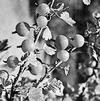- gooseberry
-
/goohs"ber'ee, -beuh ree, goohz"-/, n., pl. gooseberries.1. the edible, acid, globular, sometimes spiny fruit of certain prickly shrubs belonging to the genus Ribes, of the saxifrage family, esp. R. uva-crispa (or R. grossularia).2. a shrub bearing this fruit.[1525-35; GOOSE + BERRY]
* * *
Hardy fruit bush of the Northern Hemisphere, often placed in the genus Ribes with the currant (or alternatively assigned to the genus Grossularia as its sole member), in the family Saxifragaceae.The spiny bushes bear clusters of greenish to greenish-pink flowers. The tart, oval berries may be prickly, hairy, or smooth. They are eaten ripe and often made into jellies, preserves, pies and other desserts, or wine. Because gooseberry is an alternate host for white-pine blister rust, growing it is illegal in some states where white pine is an important resource. Gooseberry (Ribes)Derek Fell
Gooseberry (Ribes)Derek Fell* * *
▪ shrubfruit bush of the Northern Hemisphere, frequently placed in the genus Ribes, along with the currant, in the family Saxifragaceae; some taxonomic systems assign exclusively to the gooseberry the generic name Grossularia. Gooseberry bushes are spiny and produce greenish to greenish-pink flowers in clusters of two or three. The oval berries are white, red, yellow, or green with a prickly, hairy, or smooth surface.Gooseberries are extremely hardy and are grown almost as far north as the Arctic Circle. They thrive in moist, heavy clay soil in cool, humid climate. Good foliage is needed to protect the berries from the Sun. The gooseberry can withstand neglect but responds readily to good care, including potash or manure fertilizer, heavy pruning, and dormant spray to control scale and mildew. New plants are grown from cuttings.The bushes bear well for 10 to 20 years. Two- to three-year-old spurs produce the best berries. The tart fruit is eaten ripe and often made into jellies, preserves, pies, and other desserts or wine. Hundreds of varieties are grown in northern Europe, many interplanted in fruit orchards. English gooseberries (R. uva-crispa), popularly called grossularia, are native to the Old World and have long been cultivated for fruit. In Europe the large-fruited cultivated gooseberries became naturalized. Grossularia do not prosper in the United States, because they are susceptible to mildews and rusts. Because they provide an alternate host for the white-pine blister rust, it is illegal to grow grossularia in some states where white pine is an important resource. The most useful native North American species is the smooth gooseberry Ribes hirtellum, found wild across the United States; improved varieties are widely cultivated.* * *
Universalium. 2010.
